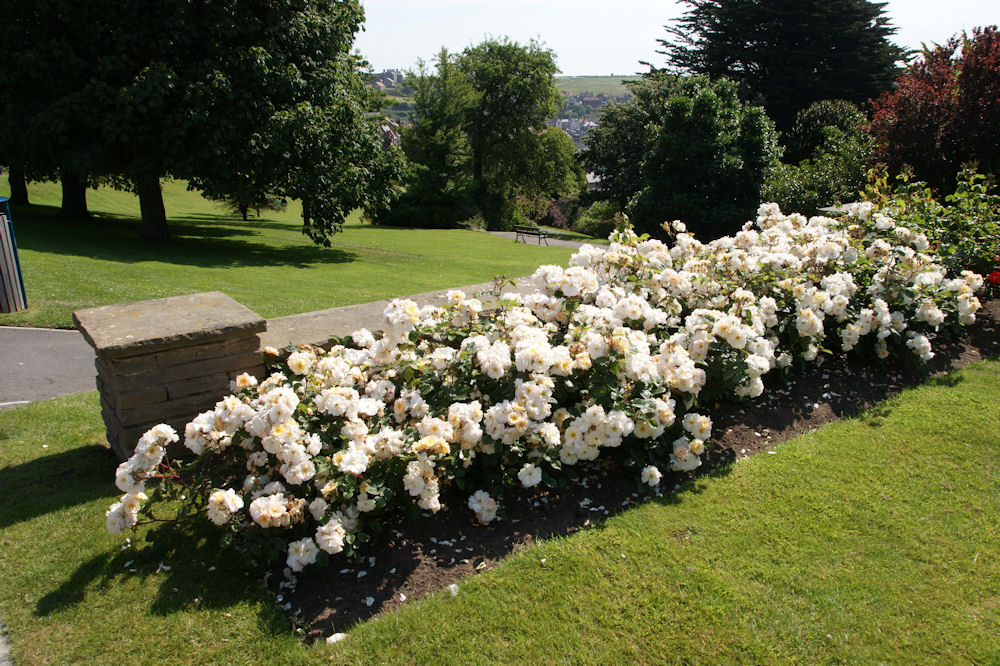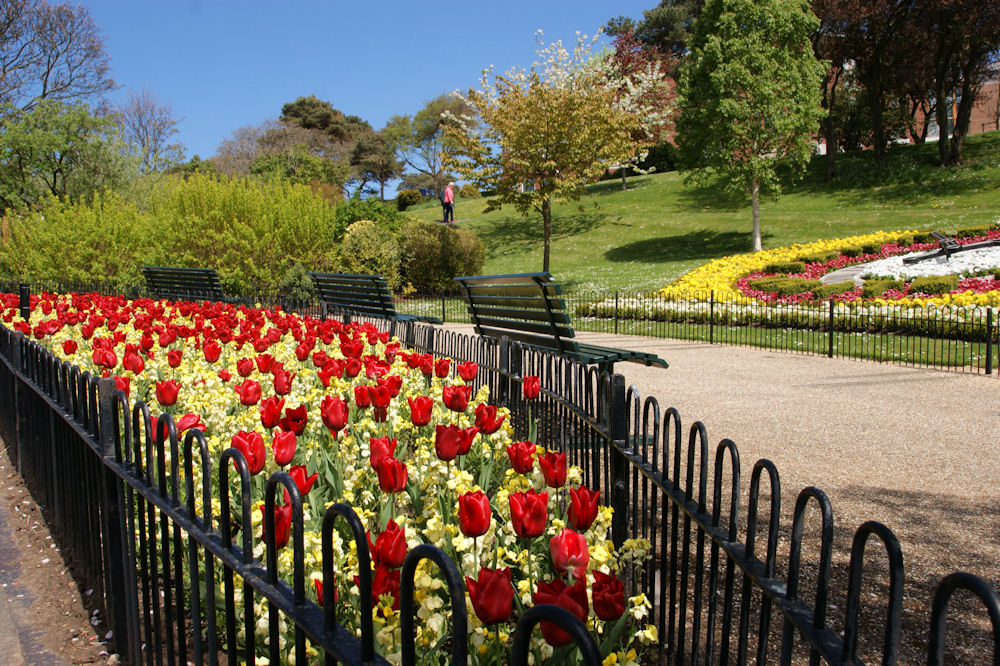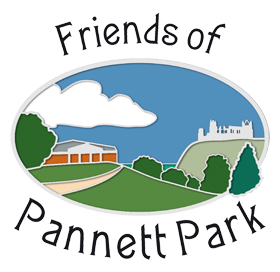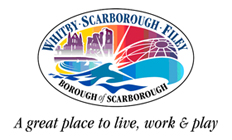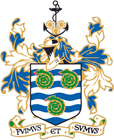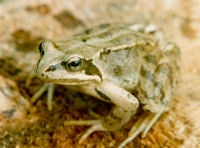
Gardening for Wildlife
Pannett Park is a great place for wildlife. It is a flourishing, green oasis close to a coastal and moorland setting. The site measures 3.3 hectares, is steeply sloped and south facing. There are woodland areas, open parkland, hedges, mixed borders and wild flower embankments all providing suitable conditions for for wildlife: food, shelter from the weather and predators, and for nesting sites. Water is found at the lily pool where rocks provide access.
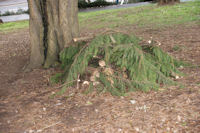
Gardening in the park is planned around the wish to enhance the environment and protect wildlife which thrives on healthy plants. Healthy plants need healthy soil, and compost bins are provided in the Community Garden, the resulting bulky organic matter being applied to the soil. Hedges are clipped tightly keeping them dense to provide cover for breeding and shelter in winter. They are not clipped during the nesting season. Leaf litter is allowed to remain under hedges, shrubs and in woodland areas. This provides cover for invertebrates, and birds enjoy foraging through it. Fallen leaves are taken down by worms enriching the soil. Fallen timber is reused in the form of log piles, both visible and invisible around the park. These have been built by local cubs and scouts providing a variety of breeding and sheltering places for all sizes of mammals and invertebrates. The ground in shrub borders is not over tidied, leaves, twigs and small branches are tucked away where they are not visible to provide cover.
Plants are carefully chosen for appropriate aspect, with the result that they thrive in the given conditions creating a beneficial environment for wildlife. Strong, salt laden northerly winds coming in from the sea are a challenge to any plant, but Phormiun tenax a New Zealand native, griselinia, tamarix, olearia, eleagnus, Hippophae rhamnoides (sea buckthorn) and escallonia are able to meet the challenge, and all thrive in Pannett Park.
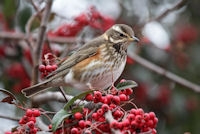
Ivy (Hedera helix) is an excellent plant for wildlife. It provides food in the form of nectar and berries at a time of year when little else is available, shelter during the winter and dense nesting places in summer. This grows around the park where it is carefully manged to keep it within bounds.
A wildlife border is planted with native berrying shrubs such as Prunus avium (wild cherry), Viburnum opulus (Guelder rose), Crataegus monogyna (hawthorn), Sambucus nigra (elder), Rosa canina (dog rose) and Malus sylvestris (wild cherry), and allowed to grow densely to provide food and shelter. Herbaceous perennials stand well into the winter before being cut down. This allows wildlife to feed on their seeds in the winter months and to find shelter in the crown of the plants.
There are plants in flower throughout the year providing pollen and nectar for those insects that fly in winter and early spring. You will find sarcococca, mahonia, hedera, aubretia, sedum, viburnum, and Hamamelis mollis, many of which are sweetly scented on mild winter days to attract insects. Tangles of clematis are left unpruned providing winter shelter, and many have attractive seed heads lasting well into winter providing food.
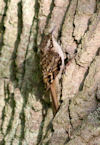
Wherever possible plants are chosen for their benefits to wildlife, that is berry or pollen bearing with single, open flowers which insects can access easily.
Nest boxes are to be found throughout the park, traditional ones for hole nesters like blue, great and coal tits, open fronted for robins and blackbirds and some for tree creepers.These are cleared and monitored yearly. Bat boxes are installed high in the Cupressus macrocarpa and Scots pine trees. Chemical usage is minimal, weeds are removed manually, plants are chosen for disease resistance which means that moulds and fungi are minimal, and there is nothing like the bird population and ladybirds for dealing with aphids.
A park rich in wildlife is a pleasure for the user. Come along in winter and watch redwings scoffing berries of Cotoneaster frigidus, in spring birds are collecting nesting materials, closely followed by searching for food for their young. Sit in the sun on the museum terrace in high summer and listen to the humming of bees on the lavandula and nepeta, and later in autumn count the butterflies on buddleia and sedum. Your life will be richer for it.
Below you will find details of the wildlife that occurs regularly in Pannett Park and some of the occasional sightings.
Birds
Blackbird
Black Cap
Blue Tit
Bullfinch
Carrion Crow
Chaffinch
Chiff Chaff
Coal Tit
Collared Dove
Feral Pigeon
Fieldfare
Garden Warbler
Goldcrest
Goldfinch
Great Tit
Greenfinch
Green Woodpecker
Grey Wagtail
Hedge Sparrow
Herring Gull
House Martin
House Sparrow
Jackdaw
Jay
Kestrel
Long Tailed Tit
Magpie
Mallard
Melodious Warbler
Mistle Thrush
Nuthatch
Oyster Catcher
Pheasant
Pied Wagtail
Redwing
Robin
Rook
Siskin
Song Thrush
Sparrow Hawk
Spotted Flycatcher
Starling
Stonechat
Swallow
Swift
Tawny Owl
Tree Creeper
Tree Sparrow
Wax Wing
Wheatear
Willow Tit
Willow Warbler
Woodcock
Wood Pigeon
Wren
Butterflies
Brimstone
Comma
Common Blue
Gatekeeper
Greenveined White
Large White
Meadow Brown
Orange Tip
Painted Lady
Peacock
Red Admiral
Ringlet
Small Copper
Small Tortoiseshell
Small White
Speckled Wood
Wood White
Bees
Bombus hypnorum (Tree Bee)
Bombus terrestris (Buff-tailed Bumblebee)
Bombus lapidarius (Red-tailed Bumblebee)
Bombus pratorum (Early Bumblebee)
Bombus lucorum (White-tailed bumblebee)
Anthophora plumipes (Hairy-footed Flower Bee)
Other Creatures Seen in the Park
Grey Squirrel, Hedgehog, Badger, Fox, Hare, Common Frog, Common Toad, Midwife toad, Common Newt have been seen.
